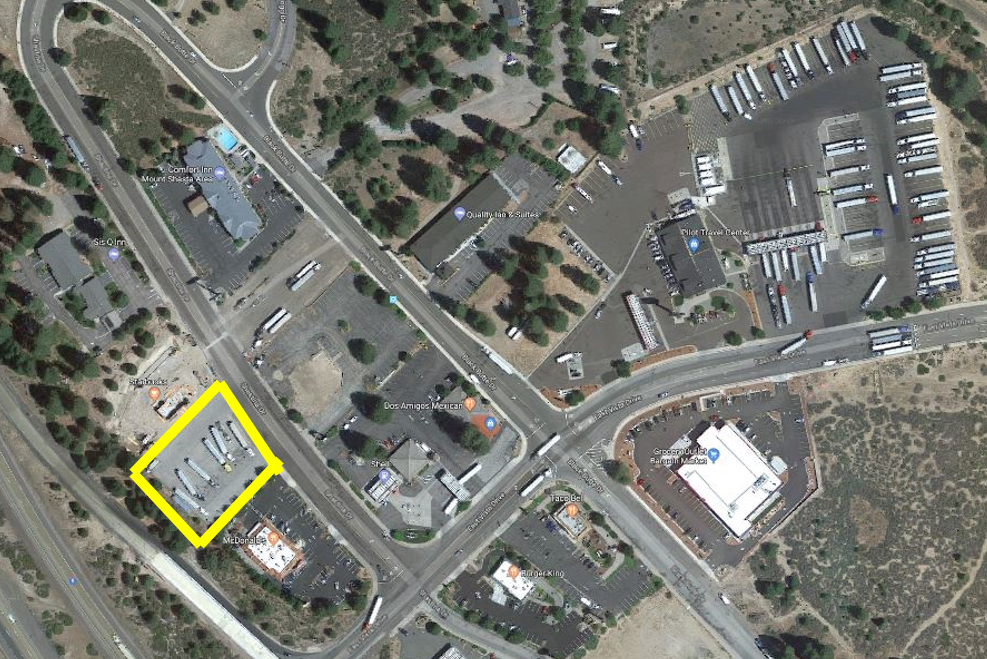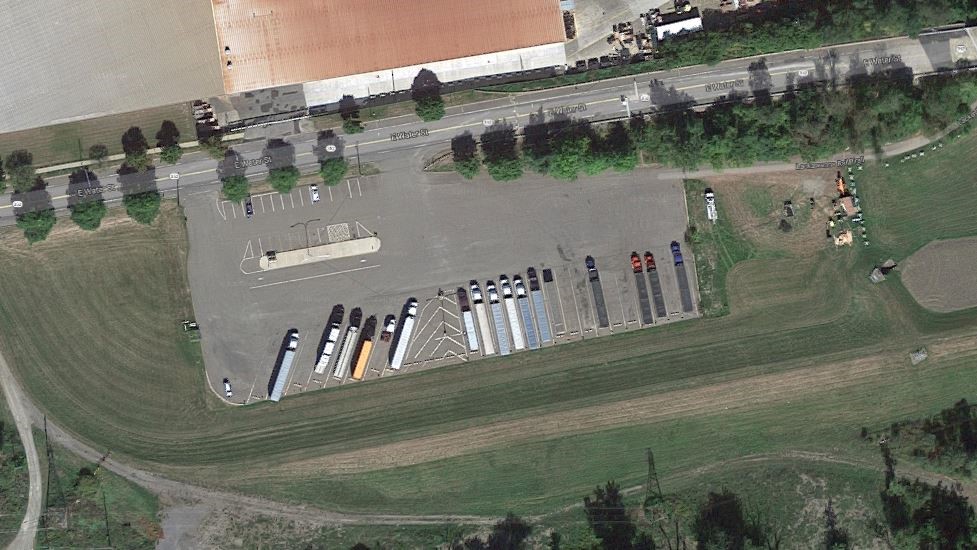National Coalition on Truck Parking: State, Regional, Local Government Coordination Group - Parking and Staging Requirements in Local Zoning and Planning
Printable Version [PDF 1.3MB]
You may need the Adobe® Reader® to view the PDFs on this page.
Contact Information: Freight Feedback at FreightFeedback@dot.gov

U.S. Department of Transportation
Federal Highway Administration
Office of Operations
1200 New Jersey Avenue, SE
Washington, DC 20590

There are several examples of local governments including provisions for truck parking and staging in their local planning and zoning. These plans and ordinances address staging, long-term parking, deliveries, and parking at home. Below are several examples that communities could consider using as a model for their own planning and zoning to help direct truck parking and staging.
Overnight Parking
Weed, CA
The City of Weed, CA, located on Interstate 5 at the base of Mount Shasta, created municipal truck parking for about 30 trucks on two pieces of city-owned land zoned for industrial use. The town was motivated to use its land to create truck parking because it recognized the important role that truck drivers play in the city's economy. Weed's City Manager noted that they have not received pushback or complaints from residents in the community. Trucks are permitted to park for up to 72 hours. In Figure 1, the purple area inside the yellow oval (oval added) on the map represents the municipal truck parking lot.

Figure 1: Map of land zoned Industrial in the City of Weed, CA. The purple area inside the yellow oval is the newly-created municipal truck parking.
Source: http://weedca.govoffice3.com/vertical/sites/%7BC0495501-9512-4786-A427-BAB3AEBDEA56%7D/uploads/Vol1_Weed-GP_BackgroundReport-fin.pdf

Figure 2: Aerial view of municipal truck parking in Weed, CA (outlined in yellow).
Source: Map data ©2018 Google, DigitalGlobe.
Moreno Valley, CA
Moreno Valley allows commercial truck parking on certain roadways in the city. Some areas are designated solely for overnight truck parking and others allow for truck parking at all times. Vehicles can park for up to 72 hours in a designated area.

Figure 3: Signs restricting parking to commercial vehicles in an industrial area in Moreno Valley, CA.
Source: Working Group member photo.

Figure 4: Map of truck parking areas in Moreno Valley, CA.
Source: http://moreno-valley.ca.us/community/pdfs/truckparking1016.pdf.
Elmira, NY
The City of Elmira created a municipal truck parking area from an existing industrial-zoned lot adjacent to a carpool parking lot. This facility is located off of Interstate 86. It provides about 25 truck parking spaces, for which the city charges $5 per day and trucks can stay for up to thirty days. Once the facility was created, complaints from residents about trucks parking in the community decreased.1

Figure 5: Aerial view of municipal truck parking lot in Elmira, NY.
Source: Map data ©2018 Google, DigitalGlobe.

Figure 6: Zoning map of Elmira, NY showing the industrial-zoned municipal truck parking lot in the yellow oval.
Source: http://www.cityofelmira.net/usr/City%20Hall/is_zoning_map.pdf
Carson, CA
The city of Carson, California designated specific areas of the city where trucks can park for up to 72 hours and where trucks can load and unload goods. The city also designated specific truck routes to provide a means to carry vehicles between the State highways and commercial zones in the city. The excerpt from the zoning code is as follows:
The parking of any commercial vehicle with a gross weight of over six thousand (6,000) pounds, length of over twenty-five (25) feet, or width of over ninety-six (96) inches (total outside width of vehicle or load or combined) is prohibited at all times on any street in the City of Carson except:
- At locations and for the time period authorized by the City Council and posted by the Public Works Director;
- For such time as is reasonably necessary to deliver to or collect goods from or provide a service to a property in the block in which the vehicle is parked. At locations where parking of commercial vehicles with a gross weight of over six thousand (6,000) pounds is permitted overnight, illuminated clearance lights or safety reflectors must be provided and utilized.

Figure 7: Map of existing truck routes and parking locations in Carson, CA.
Source: http://ci.carson.ca.us/content/files/pdfs/ENGINEERING/traffic_engineering/TrckPrkng_Existing_11x17.pdf
To learn more about Carson's truck routes, please visit http://ci.carson.ca.us/PublicWorks/truckroutes.aspx
Staging and Loading
Similar to the employee and customer parking requirements contained in most zoning ordinances, truck parking requirements can be established for uses that frequently generate truck traffic. Standards could be set for truck parking and staging areas relative to the number of loading zones. Traffic impact studies could also be used to estimate the amount of truck trips that will be generated by a proposed use. Having provisions for truck parking in the zoning ordinance also allows the community to set standards for siting and design to ensure compatibility with surrounding land uses. Standards could be established for location, screening, lighting, security, and power connections to prevent the need for trucks to idle. Below are a couple of communities that are working to address these issues.
Chicago, IL
The City of Chicago implemented the Downtown Loading Zone Reform Pilot in 2017. This pilot converted all business-paid commercial curbside loading zones to user-paid curbside loading zones in the central business district. New York City and Washington, DC have instituted similar programs. The intention of the Chicago program is to help balance parking supply and demand, improve traffic flow, and increase availability of parking. After the pilot program proved successful, the initiative expanded to other congested areas and was added to the Municipal Code of Chicago under section 9-64-165: Commercial loading zones.

Figure 8: Map showing the Central Business District of Chicago, where the Downtown Loading Zone Reform Pilot took place.
Map data ©2018 Google.
Philadelphia, PA
In May 2018, the City of Philadelphia's Office of Transportation & Infrastructure Systems issued a Request for Information (RFI) about options to provide long-haul and local-serving tractor trailer truck parking in the city of Philadelphia. The information obtained from the RFI will inform city policies, future actions, and potential contracting opportunities related to truck parking facilities in Philadelphia. The RFI discusses the region's lack of adequate facilities and resources for truck parking and even references the Jason's Law survey. In 2017, the City of Philadelphia formed a Truck Circulation and Delivery Management Working Group to focus on issues related to goods movement. Most relevant to this RFI, the Working Group seeks to identify strategies, business models, and locations for tractor trailer parking to meet the needs of long-haul and owner-operator truck drivers. The goals for the RFI are to:
- Identify opportunities and interest in establishing a full-service truck stop in Philadelphia, primarily for the use of long-haul truck drivers.
- Identify opportunities to establish safe, affordable, and convenient parking options for locally based tractor trailer drivers to park their vehicles when not in use, such as in a secured lot that leases spaces.
- Identify short-term parking options for any trucker who needs to wait before making a pick up or drop off.
For more information on the RFI, please visit https://bigideasphl.com/2018/05/14/rfi-tractor-trailer-truck-parking-options-in-philadelphia/ or https://www.phila.gov/rfp/pages/default.aspx
APA Policy Recommendations
The American Planning Association (APA) has agreed on certain policy recommendations for increasing truck parking supply in municipalities.
Below is one of APA's policy recommendations:
That traffic and parking regulations accommodate local freight demand: Municipalities should require loading zones to be incorporated in new developments and set standards for them as well as for loading docks as a part of certain land uses. Providing appropriate locations for truck lay-by parking to accommodate required driver rest periods should also be considered.
When drafting ordinances, municipalities should take this policy recommendation into consideration to ensure truck parking is properly addressed.
The examples in this report show innovative solutions for truck parking applied in a range of situations. Suitability in other locations will depend on applicable Federal laws, State standards, and site-specific considerations. This document is disseminated under the sponsorship of the U.S. Department of Transportation in the interest of information exchange. The U.S. Government assumes no liability for the use of the information contained in this document. This report does not constitute a standard, specification, or regulation. It does not create any requirements other than those stipulated in statute or regulation. The U.S. Government does not endorse products or manufacturers. Trademarks or manufacturers' names appear in this report only because they are considered essential to the objective of the document. They are included for informational purposes only and are not intended to reflect a preference, approval, or endorsement of any one product or entity.